

|
 |
Tweet
|
|
|
|
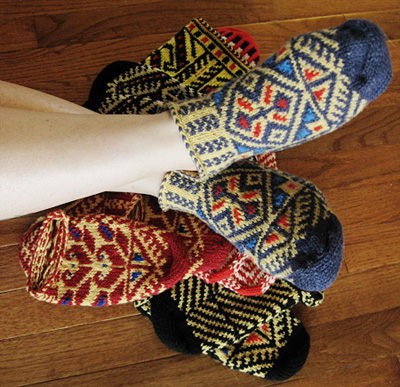 I'm not only a crazy-obsessed knitter, but I am also a crazy-obsessed traveler. A few years ago while visiting a friend in England, I mentioned that I wanted to learn more about Eastern European knitting. Before I knew it, June was putting a book into my hands. The title, Black Lambs and Grey Falcons: Women Travelling in the Balkans got my attention right away. "Don't miss the chapter about Edith Durham," June said. "She traveled in Yugoslavia before World War I and collected traditional clothing." I started flipping through the pages. "Oh," June said as if it were an afterthought. "Edith Durham's collection is at a museum in Halifax. We'll be passing by that way when I take you to the airport." I tried to remain calm, but I knew I would have to visit that museum before I headed back to the states. Such was the beginning of my love affair with Balkan knitting. Before I stumbled onto Black Lambs and Grey Falcons andthe socks in the Edith Durham collection, the only thing I knew about the former Yugoslavia and the Balkans was that it was a violent, dangerous part of the world. I remember reading articles in the paper about Serbs, Croats, and Bosnians, Orthodox Christians, Roman Catholics, and Muslims. (The region is currently peaceful, the economy is growing, and tourism is increasing. I hope it will remain that way.) All of these, often conflicting, cultures have contributed to the unique flavor of the traditional knitting patterns of the region. Almost every history of the knitting that I've read places the birth of knitting somewhere in the Middle East, spreading later into Europe, and finally to North America only a few hundred years ago. Because the Balkans were invaded by the Ottoman empire, even today a strong Turkish influence can be seen in the knitting patterns and techniques of the region. Turkish knitting may have been developed first by shepherds who had easy access to wool, and who were already familiar with spinning, dyeing, and working with yarn to make rugs. I can easily imagine Moorish knitters taking their new craft with them into Eastern Europe, Portugal and Spain. With my active imagination, I wasn't at all surprised when I read Fancy Feet: Traditional Knitting Patterns of Turkey, and learned that Anna Zilboorg also envisioned the spread of knitting following the spread of Islam. Later Roman Catholic missionaries and colonists brought the same style of knitting across the Atlantic to South America. One of my favorite things about knitting is the amazing variety of pattern and technique. From just two simple stitches (knit and purl), endless combinations of texture and color can be created. The socks of this region, tucked away between the worlds of East and West, are often called jorabs, from the Arabic word for socks. They are worked from the toe up, with several different types of toe shaping. The Bosnian toe, which is worked back and forth in stockinette stitch with no purls, is one of my favorites (if that sounds mysterious, check out the instructions in the pattern below.) The heels are often added after the body of the sock is complete. Knitted from heavy, coarse wool, they are probably the warmest socks I have ever worn. The designs are brightly colored with horizontal or vertical bands of brightly-colored geometric patterns, possibly because of the Islamic prohibition against making pictures of living things. Many of the patterns used in Eastern European socks include motifs that remind me of oriental carpets.
Although each stitch is just a simple loop, people around the world have invented some ingenious methods of working the knit and purl stitch. Traditionally in many Eastern countries, knitters tensioned their yarn by stringing it around their neck, with the balls of yarn held on the knitter’s left, and the yarn traveling around the back of the neck to attach to the needles from the right. Similar techniques were used in Turkey, in the Balkans, and in Greece, Portugal, and Peru. Because I haven't visited the Balkans yet, I'm not sure exactly how women in the nations of former Yugoslavia held their knitting and worked their stitches. I do know that today many knitters work in the Continental style that we are more familiar with in Western Europe and America. But in Portugal and Peru, most knitters still tenstion their yarn in the old style. In some places, circular knitting is worked on the inside of the tube, and stitches are purled by flicking the yarn around the tip of the needle with the right thumb. This creates a stockinette stitch fabric with the knit surface on the outside. Here's how: To tension the yarn, place the ball of yarn on your left and run the yarn around the back of your neck from left to right. (Wearing a turtleneck or a shirt with a collar will keep you from getting friction burn on the back of your neck.) The yarn should be taut, like a guitar string. If you need extra tension, try putting some extra drag on it by setting your yarn on the floor or running it under your left arm before it goes around your neck. Or, you can follow the Portuguese example and buy a special knitting pin to run your yarn through.
Position your knitting so the join where the working yarn is attached to the knitting is away from you, on the far side of the tube. Because this type of knitting is worked from the inside, all stitches are purled to acheive stockinette stitch. The knit side will be on the outside of the needles, just as with standard American and European techniques.
To make a stitch with the yarn tensioned around your neck: Insert the right needle into the front loop of the first stitch on the left needle as if to purl, and use your left thumb to pull the yarn around the back of the front needle from right to left.
Pull out your thumb and let the yarn catch on the needle, then pull the yarn through to complete the stitch. (When you pull your thumb out, the working yarn will catch on the needle and you can pull the new loop through. If the yarn falls off the needle, your yarn is not tensioned tightly enough.) When you are working with two colors on the same row, use your right thumb to separate the strands of yarn. When you purl with the main color, lift the contrasting color up and out of the way. When you purl with the contrasting color, pull the main color down and out of the way.
This neck-tensioning technique makes it very easy to work with multiple colors, but Balkan patterns can be knit with any knitting style. When working with two colors, you can carry both colors in your left hand, both in your right hand, or one in each. Working with more than two colors in a row, however, requires more nimble fingers if you’re not tensioning the yarn around your neck! If you’ve never worked with multiple colors before, socks make great starter projects. They’re small enough that you won’t be intimidated by a year-long project but big enough to give you enough practice to feel like you’re getting somewhere. Learn More Ethnic Socks & Stockings: A Compendium of Eastern Design & Technique (Hardcover) by Priscilla A. Gibson-Roberts, XRX Inc., Sioux Falls, South Dakota, 1995. Fancy Feet: Traditional Knitting Patterns of Turkey (Hardcover) by Anna Zilboorg, Lark Books, Asheville, North Carolina, 1994. Confusingly, the paperback version of the same book has a different title. Simply Socks: 45 Traditional Turkish Patterns to Knit (Paperback) by Anna Zilboorg, Lark Books, Asheville, North Carolina, 2001. Knitted Stockings from Turkish Villages (Paperback) by Kenan Ozbel, Is Bankasi Cultural Publications, Istanbul, Turkey, 1981. |
|
|
| SIZE |
| Women’s S [M, L] |
| finished measurements |
Circumference: 7.5 [8.25,
9] inches |
MATERIALS
Notions |
| GAUGE |
32 sts/36 rounds = 4 inches in stockinette stitch over stranded color knitting on larger needles |
| PATTERN NOTES [Knitty's list of standard abbreviations and techniques can be found here.] |
These socks are worked from the toe up with a Bosnian toe. The initial portion of the toe is worked flat, the rest of the sock is worked in the round. Stitches are worked in scrap yarn to create the heel opening. The scrap yarn is removed and the heel worked after the rest of the sock is complete. The small amount of red in the Instep chart on rows 24-32 can be knit in as you go or added with duplicate stitch after the knitting is complete. Charts sole+instep Small • Medium • Large * heel [all sizes], cuff and chart key |
| DIRECTIONS |
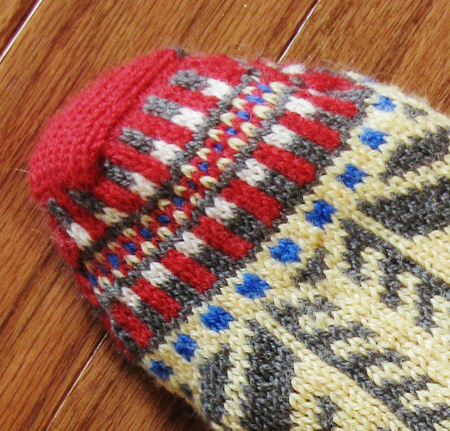 Using the long-tail cast on and holding two of the smaller needles tog, with D, CO 11 sts. Note: Casting on over two needles makes the first row of stitches a little looser than usual; this makes it easier when you have to pick up these stitches in the second step. Remove one ndl. With RS facing, pick up and knit 13 sts along side first of this rectangle, 10 sts along CO edge, and 14 sts along other side—48 sts total. Knit one round even. 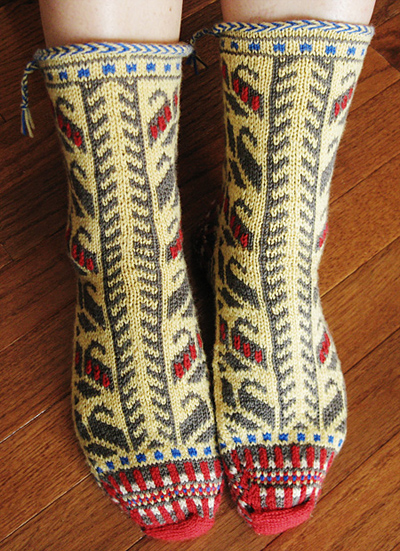 Change to larger needles. Foot Round: Work appropriate size of Sole Chart across first
24 sts of round, work appropriate size of Instep Chart across second
half of round. Cont working charts as established until sock measures 7[7.5, 8] inches or 3 inches short of desired foot length, repeating rows 21-52 of the charts. Heel OpeningWith scrap yarn, knit across the first 30[34, 36] sts of the round. Leg Beginning again at the start of the round, working over the scrap yarn, work around the leg as follows: Leg round, sizes S & L: Starting at the
row where you left off on the foot, work Instep chart twice across round. 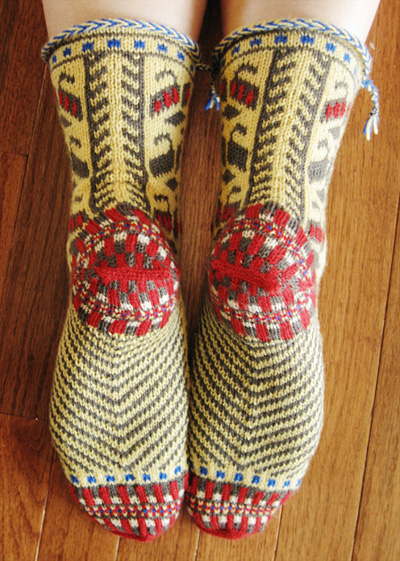 Cuff round: Work Cuff Chart across round. Continue until all rows of Cuff Chart are complete. Knit 2 rounds even with MC. Work braided edge as follows: Carefully Remove waste yarn and distribute heel sts onto needles as you prefer – you should have 60[68, 74] sts total – 30[34, 36] from the top and 30[34, 36] from the bottom. The start of the round is at the side edge between the bottom of the heel and the back of the heel. Heel round: Work appropriate
size of Heel Chart twice across round. BO knitwise with D. |
| finishing |
| With sock right-side out, whip stitch the heel seam together or, if you prefer, graft the stitches together. Turn the BO edge to the inside and sew down so the braid is at the top edge of the sock. Weave in ends. If desired, pull the ends from the bind off at the cuff to the outside and braid them together. |
| ABOUT THE DESIGNER |
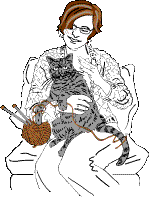 She lives in Colorado with her husband, mother, and three cats who all help her test the usability and comfort of her finished knitted items. Visit Donna's website at sheeptoshawl.com.
|
|
Pattern & images © 2011. Donna Druchunas. Contact Donna |